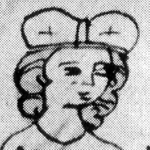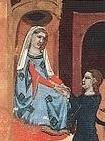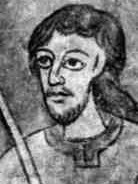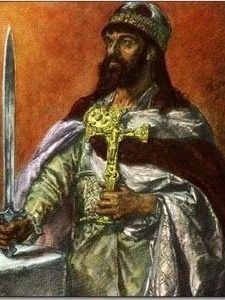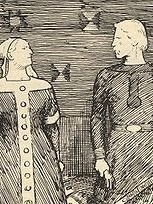Familienstammbaum Snelder - Versteegh » Queen Doubravka of Bohemia (930-977)
Persönliche Daten Queen Doubravka of Bohemia
Quellen 1, 2- Sie ist geboren im Jahr 930 in Praha, Czechoslovakia.
- Sie ist verstorben im Jahr 977, sie war 47 Jahre alt.
- Ein Kind von Boleslav I "The Cruel" of Bohemia und Biagota of Bulgaria?
Familie von Queen Doubravka of Bohemia
(1) Sie ist verheiratet mit Mieszko I of Poland.
Sie haben geheiratet rund 942.
Kind(er):
(2) Sie ist verheiratet mit Gunther of Meissen.
Sie haben geheiratet
Kind(er):
Notizen bei Queen Doubravka of Bohemia
https://en.wikipedia.org/wiki/Doubravka_of_Bohemia
Doubravka of Bohemia or Dobrawa, Dąbrówka (Czech: Doubravka Přemyslovna, Polish: Dobrawa Przemyślidka, Dąbrówka Przemyślidka) (ca. 940/45 – 977) was a Bohemian princess of the Přemyslid dynasty and by marriage Duchess of the Polans.
She was the daughter of Boleslav I the Cruel, Duke of Bohemia, whose wife may have been the mysterious Biagota.[1][2]
According to earlier sources, Dobrawa urged her husband Mieszko I of Poland to accept baptism in 966, the year after their marriage. Modern historians believe, however, that the change of religion by Mieszko was one of the points discussed in the Polish-Bohemian agreement concluded soon before his marriage with Dobrawa. Her role in his conversion is not considered now to be as important as it is often represented in medieval chronicles.
Dobrawa's date of birth is not known. The only indication is communicated by the chronicler Cosmas of Prague, who stated that the Bohemian princess at the time of her marriage with Mieszko I was an old woman.[3] The passage is regarded as tendentious and of little reliability, and some researchers believe that the statement was made with malicious intent.[4] It is possible that in the statement about Dobrawa's age, Cosmas was making a reference to the age difference between her and her sister Mlada. That would give him a basis for determining Dobrawa as "old." It[citation needed] also found that Cosmas confuses Dobrawa with Mieszko I's second wife Oda, who at the time of her marriage was around 19–25 years old, a relatively advanced age for a bride according to the customs of the Middle Ages. Some researchers have taken up speculative views, such as Jerzy Strzelczyk, who assumed that in the light of contemporary concepts and habits of marriage of that time (when as a rule marriages were contracted with teenage girls) is assumed that Dobrawa had passed her early youth, so, it's probable that she was in her late teens or twenties.[5]
Nothing is known about Dobrawa's childhood and youth. In 1895 Oswald Balzer refuted reports that previous to her marriage with Mieszko I, Dobrawa was married to Gunther, Margrave of Merseburg and they had a son, Gunzelin. This view is based on the fact that Thietmar of Merseburg in his chronicles named Gunzelin, Gunther's son, brother of Bolesław I the Brave, Dobrawa's son.[6] Currently, historians believed that Gunzelin and Bolesław I are in fact cousins or brothers-in-law.[7]
In the second half of 964[8] an alliance between Boleslav I the Cruel, Duke of Bohemia, and Mieszko I of Poland was concluded. In order to consolidate the agreement, in 965 Boleslav I's daughter Dobrawa was married to Mieszko I. There was a difference of religion between the spouses; she was a Christian, he was a pagan.
Two independent sources attribute to Dobrawa an important role in the conversion to Christianity of Mieszko I and Poland. The first is the chronicles of Thietmar, who was born two years before the death of Dobrawa. He wrote that the Bohemian princess tried to persuade her husband to accept Christianity (even at the cost of breaking their marriage and with it the Polish-Bohemian Alliance). In the end, she finally obtained the conversion of Mieszko I and with him, of all Poland.[9]
In turn, the 12th century chronicler Gallus Anonymus says that Dobrawa came to Poland surrounded by secular and religious dignitaries. She agreed to marry Mieszko I providing that he was baptized. The Polish ruler accepted, and only then was able to marry the Bohemian princess.
However, modern historians allege that the baptism of Mieszko I was dictated by political benefits and should not be attributed to any action of Dobrawa, who according to the modern view had virtually no role in the conversion of her husband.[10] They note that the conversion of Mieszko I thanks to Dobrawa formed part of the tradition of the Church which stressed the conversion of Pagan rulers through the influence of women.[11]
On the other hand, literature doesn't refuse to give Dobrawa a significant role in the Christianization of the Poles. In her wedding procession, she arrived in Poland with Christian clergymen, among them possibly Jordan, ordained the first Bishop of Poland in 968. Tradition attributes to Dobrawa the establishment of the Holy Trinity and St. Wit Churches in Gniezno and the Church of the Virgin Mary in Ostrów Tumski, Poznań.
Dobrawa's marriage cemented the alliance of Mieszko I with Bohemia, which continued even after her death. On 21 September 967 Mieszko I was assisted by Bohemians in the decisive battle against the Wolinians led by Wichmann the Younger.
When, after the death of Emperor Otto I in 973, a struggle for the supremacy in Germany began, both Dobrawa's husband and brother Boleslav II the Pious, Duke of Bohemia, supported the same candidate for the German throne, Duke Henry II of Bavaria.
The marriage of Mieszko I and Dobrawa produced three children:
- Bolesław I the Brave (Chrobry) (b. 967 - d. 17 June 1025).
- a daughter, perhaps named Świętosława, perhaps identical to the legendary Sigrid the Haughty (b. 968/72 - d. ca. 1016), perhaps married firstly with Eric the Victorious, King of Sweden, and later wife of Sweyn Forkbeard, King of Denmark, by whom she is said to have been mother of Canute the Great, King of Denmark, Norway and England. Gunhilda of Poland, who married Swyen I "Forkbeard", King of Denmark and England, is usually identified with Sigrid.
- There is an hypothesis asserting the existence of another daughter of Mieszko I who was married to a Pomeranian Slavic Prince. She could have been the daughter of either Dobrawa or one of Mieszko's previous pagan wives.[12]
- Also, a theory has been advanced (apparently recorded by Thietmar and supported by Oswald Balzer in 1895) that Vladivoj (c. 981 – January 1003), who ruled as Duke of Bohemia during 1002–1003, was another son of Dobrawa and Mieszko I.[1] Although modern historians have rejected this hypothesis,[citation needed]Czech historiography has supported the notion of mixed Piast-Přemyslid parentage for Vladivoj.[13]
Dobrawa died in 977. In his study of 1888, Józef Ignacy Kraszewski wrote that "her tomb was discovered in Gniezno Cathedral. It was a simple stone marked with a cross. Purple robes and a weighty gold loincloth were the only objects found in her tomb."[14] A similar view of Dobrawa's burial place was expressed earlier, in 1843, by Edward Raczyński in his study Wspomnienia Wielkopolski to jest województw poznańskiego, kaliskiego i gnieźnieńskiego (Memories of the Greater Poland districts of Poznań, Kalisz and Gniezno).[15] However, the burial place of the Bohemian princess is now considered to be unknown.[16]
Dobrawa's death weakened the Polish-Bohemian alliance, which finally collapsed in the mid-980s.
Zeitbalken Queen Doubravka of Bohemia
 Großeltern
Großeltern
 Eltern
Eltern
 Geschwister
Geschwister
 Kinder
Kinder
Vorfahren (und Nachkommen) von Doubravka of Bohemia
Doubravka of Bohemia  | |||||||||||||||||||||||||||||||||||
(1) ± 942 | |||||||||||||||||||||||||||||||||||
Mieszko I of Poland | |||||||||||||||||||||||||||||||||||
(2) | |||||||||||||||||||||||||||||||||||
Gunther of Meissen | |||||||||||||||||||||||||||||||||||
Quellen
- WikiTree, via https://www.myheritage.nl/research/colle...
Dubravka BohemiaGeslacht: VrouwGeboorte: Ongeveer 931 - Praha, CzechoslovakiaHuwelijk: Ongeveer 942Vader: Boleslav II BohemiaMoeder: Ælfgifu Bohemia (geboren Wessex)Echtgenoot: Mieszko I of PolandKind: Boleslav I of PolandBroers/zusters: Boleslav BohemiaOldrich of Bohemia (geboren Bohemia)
www.wikitree.com
- Biographical Summaries of Notable People, via https://www.myheritage.nl/research/colle...
Doubravka of BohemiaGeslacht: VrouwGeboorte: 930Overlijden: 977Huwelijk: Partner: Mieszko I of Poland - 965 Familieleden: RelatieNaamGeboorteVaderBoleslaus I, Duke of BohemiaMoederBiagotaZoonBolesław I Chrobry967DochterSigrid The Haughty967EchtgenootMieszko I of Poland930
The records in this collection vary in what data items are present and one will find information on various aspects of the subject persons including names, biographical descriptions, nationalities, birth dates, birth places, death dates, death places, relatives, spouses, children, professions, nationalities, and educational attainment. The information in this collection has been compiled from Freebase (under CC-BY) and Wikipedia (under the GNU Free Documentation License).
Über den Familiennamen Of Bohemia
- Zeigen Sie die Informationen an, über die Genealogie Online verfügt über den Nachnamen Of Bohemia.
- Überprüfen Sie die Informationen, die Open Archives hat über Of Bohemia.
- Überprüfen Sie im Register Wie (onder)zoekt wie?, wer den Familiennamen Of Bohemia (unter)sucht.
Roel Snelder, "Familienstammbaum Snelder - Versteegh", Datenbank, Genealogie Online (https://www.genealogieonline.nl/stamboom-snelder-versteegh/I504160.php : abgerufen 28. Mai 2024), "Queen Doubravka of Bohemia (930-977)".
